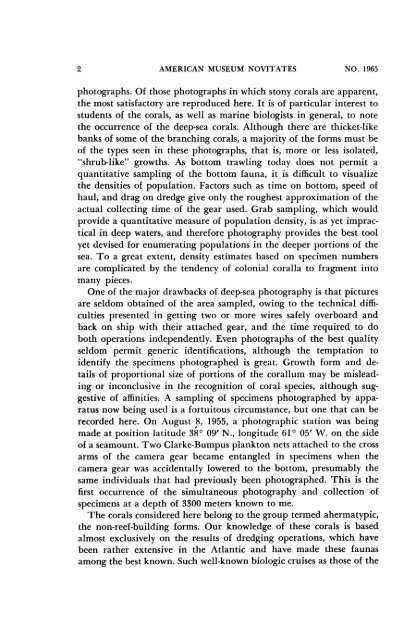MXieuicanJAuscum - American Museum of Natural History
MXieuicanJAuscum - American Museum of Natural History
MXieuicanJAuscum - American Museum of Natural History
Create successful ePaper yourself
Turn your PDF publications into a flip-book with our unique Google optimized e-Paper software.
2 AMERICAN MUSEUM NOVITATES<br />
NO. 1 965<br />
photographs. Of those photographs in which stony corals are apparent,<br />
the most satisfactory are reproduced here. It is <strong>of</strong> particular interest to<br />
students <strong>of</strong> the corals, as well as marine biologists in general, to note<br />
the occurrence <strong>of</strong> the deep-sea corals. Although there are thicket-like<br />
banks <strong>of</strong> some <strong>of</strong> the branching corals, a majority <strong>of</strong> the forms must be<br />
<strong>of</strong> the types seen in these photographs, that is, more or less isolated,<br />
"shrub-like" growths. As bottom trawling today does not permit a<br />
quantitative sampling <strong>of</strong> the bottom fauna, it is difficult to visualize<br />
the densities <strong>of</strong> population. Factors such as time on bottom, speed <strong>of</strong><br />
haul, and drag on dredge give only the roughest approximation <strong>of</strong> the<br />
actual collecting time <strong>of</strong> the gear used. Grab sampling, which would<br />
provide a quantitative measure <strong>of</strong> population density, is as yet impractical<br />
in deep waters, and therefore photography provides the best tool<br />
yet devised for enumerating populations in the deeper portions <strong>of</strong> the<br />
sea. To a great extent, density estimates based on specimen numbers<br />
are complicated by the tendency <strong>of</strong> colonial coralla to fragment into<br />
many pieces.<br />
One <strong>of</strong> the major drawbacks <strong>of</strong> deep-sea photography is that pictures<br />
are seldom obtained <strong>of</strong> the area sampled, owing to the technical difficulties<br />
presented in getting two or more wires safely overboard and<br />
back on ship with their attached gear, and the time required to do<br />
both operations independently. Even photographs <strong>of</strong> the best quality<br />
seldom permit generic identifications, although the temptation to<br />
identify the specimens photographed is great. Growth form and details<br />
<strong>of</strong> proportional size <strong>of</strong> portions <strong>of</strong> the corallum may be misleading<br />
or inconclusive in the recognition <strong>of</strong> coral species, although suggestive<br />
<strong>of</strong> affinities. A sampling <strong>of</strong> specimens photographed by apparatus<br />
now being used is a fortuitous circumstance, but one that can be<br />
recorded here. On August 8, 1955, a photographic station was being<br />
made at position latitude 380 09' N., longitude 610 05' W. on the side<br />
<strong>of</strong> a seamount. Two Clarke-Bumpus plankton nets attached to the cross<br />
arms <strong>of</strong> the camera gear became entangled in specimens when the<br />
camera gear was accidentally lowered to the bottom, presumably the<br />
same individuals that had previously been photographed. This is the<br />
first occurrence <strong>of</strong> the simultaneous photography and collection <strong>of</strong><br />
specimens at a depth <strong>of</strong> 3300 meters known to me.<br />
The corals considered here belong to the group termed ahermatypic,<br />
the non-reef-building forms. Our knowledge <strong>of</strong> these corals is based<br />
almost exclusively on the results <strong>of</strong> dredging operations, which have<br />
been rather extensive in the Atlantic and have made these faunas<br />
among the best known. Such well-known biologic cruises as those <strong>of</strong> the
















